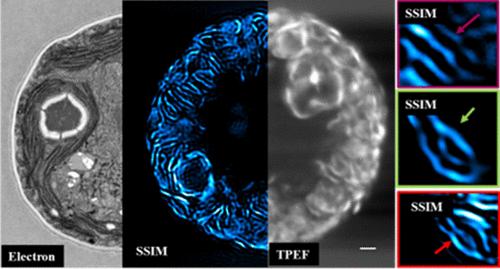利用扫描结构照明超分辨率显微镜对雨嗜血球菌生理状态的多维表征
IF 6.7
1区 化学
Q1 CHEMISTRY, ANALYTICAL
引用次数: 0
摘要
雨生红球菌(HP)是一种淡水藻类,以其积累强抗氧化剂虾青素的能力而闻名,虾青素在水产养殖、制药和化妆品中有着广泛的应用。虾青素在不利的环境条件下迅速积累。然而,各种胁迫条件下虾青素积累的机制尚不清楚。这主要源于当前成像技术的局限性,缺乏超分辨率、无标签和三维(3D)成像能力。在本研究中,我们采用扫描结构照明显微镜(SSIM)实现了不同应激条件下HP细胞的动态三维超微结构重建。这种先进的成像方法使我们能够近距离观察HP细胞的应激反应,揭示不同应激源诱导的显著形态学变化。此外,我们研究了在这些条件下HP细胞壁的变化,并探讨了在相同的应激持续时间内这些形态学变化与虾青素积累速率之间的关系。结果清楚地表明,与盐胁迫相比,光胁迫导致整个细胞更全面的破坏,导致虾青素积累的速度更快,盐胁迫的影响是从外部向内施加的。光胁迫下虾青素的积累速率约为盐胁迫下的两倍。我们的发现为HP中虾青素积累的亚细胞动力学提供了新的见解,强调了超分辨率技术在澄清这些过程中的有效性。本文章由计算机程序翻译,如有差异,请以英文原文为准。

Multidimensional Characterization of the Physiological State of Hematococcuspluvialis Using Scanning Structured Illumination Super-Resolution Microscopy
Haematococcus pluvialis (HP) is a freshwater alga known for its ability to accumulate the potent antioxidant astaxanthin, which has extensive applications in aquaculture, pharmaceuticals, and cosmetics. Astaxanthin rapidly accumulates under unfavorable environmental conditions. However, the mechanisms of astaxanthin accumulation under various stress conditions remain unclear. This mainly stems from the limitations of current imaging techniques, which lack super-resolution, label-free, and three-dimensional (3D) imaging capabilities. In this study, we employed scanning structured illumination microscopy (SSIM) to achieve dynamic 3D ultrastructural reconstructions of HP cells under various stress conditions. This advanced imaging approach allowed us to closely observe the stress responses of HP cells, revealing significant morphological changes induced by different stressors. Additionally, we examined alterations in the HP cell wall under these conditions and explored the relationship between these morphological changes and the rate of astaxanthin accumulation during identical stress durations. The results clearly demonstrate that light stress, which induces a more comprehensive disruption of the entire cell, leads to a faster rate of astaxanthin accumulation compared to salt stress, which exerts its effects from the exterior inward. The rate of astaxanthin accumulation under light stress is approximately twice that observed under salt stress conditions. Our findings offer new insights into the subcellular dynamics of astaxanthin accumulation in HP, underscoring the effectiveness of super-resolution techniques in clarifying these processes.
求助全文
通过发布文献求助,成功后即可免费获取论文全文。
去求助
来源期刊

Analytical Chemistry
化学-分析化学
CiteScore
12.10
自引率
12.20%
发文量
1949
审稿时长
1.4 months
期刊介绍:
Analytical Chemistry, a peer-reviewed research journal, focuses on disseminating new and original knowledge across all branches of analytical chemistry. Fundamental articles may explore general principles of chemical measurement science and need not directly address existing or potential analytical methodology. They can be entirely theoretical or report experimental results. Contributions may cover various phases of analytical operations, including sampling, bioanalysis, electrochemistry, mass spectrometry, microscale and nanoscale systems, environmental analysis, separations, spectroscopy, chemical reactions and selectivity, instrumentation, imaging, surface analysis, and data processing. Papers discussing known analytical methods should present a significant, original application of the method, a notable improvement, or results on an important analyte.
 求助内容:
求助内容: 应助结果提醒方式:
应助结果提醒方式:


